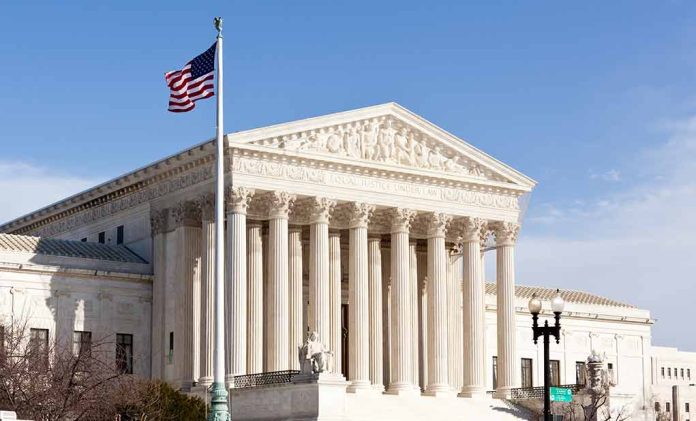
Supreme Court backs FDA regulation over sweet-flavored vaping products in a unanimous decision, potentially changing the landscape of youth nicotine use – but the legal battle isn’t finished yet.
Key Takeaways
- The Supreme Court unanimously overturned a Fifth Circuit ruling, upholding the FDA’s authority to regulate sweet-flavored vaping products.
- Justice Samuel Alito authored the opinion, noting how flavored products appeal to middle and high school students.
- Despite the ruling, the case returns to the appeals court for further review on specific issues like Triton’s marketing plan.
- The FDA has rejected over one million flavored nicotine product applications while approving some tobacco and menthol options.
- The future of vaping regulations remains uncertain as policies may shift under the Trump administration.
Supreme Court Delivers Unanimous Support for FDA Authority
The Supreme Court has unanimously sided with the Food and Drug Administration in its ongoing efforts to regulate sweet-flavored vaping products. The decision, written by Justice Samuel A. Alito Jr., overturns a previous ruling by the U.S. Court of Appeals for the Fifth Circuit that had found the FDA acted unlawfully when rejecting applications from e-cigarette manufacturers. This ruling maintains, at least temporarily, an FDA order that prohibits the marketing of flavored tobacco products believed to contribute significantly to youth nicotine addiction.
Breaking news: The Supreme Court ruled unanimously that the Food and Drug Administration properly rejected applications to market fruit- and dessert-flavored liquids for e-cigarettes that the agency says are popular with young people who risk getting hooked on nicotine.…
— The Washington Post (@washingtonpost) April 2, 2025
Justice Alito specifically highlighted concerns about flavored products appealing to middle and high school students, noting how these sweet options have contributed to increased demand among young Americans. The Court rejected the appeals court’s assertion that the FDA had acted “arbitrarily and capriciously” in denying applications for sweet-flavored vaping products, instead finding that the agency’s actions were largely consistent with its published guidance on tobacco regulations.
Not a Final Victory for Either Side
While the ruling represents a significant win for public health advocates, it doesn’t fully resolve the dispute. The Supreme Court has sent the case back to the Fifth Circuit for additional review on specific issues, including the FDA’s failure to consider Triton Distribution’s marketing plan when rejecting their application to sell flavored e-juices. This detail could potentially influence the final outcome as the legal battle continues. The FDA has rejected over a million flavored nicotine product applications, consistently citing a lack of demonstrated net public benefit.
The FDA’s regulatory approach could also shift under President Donald Trump’s administration. Recently, Brian King, the agency’s top tobacco regulator, was removed amid federal health workforce cuts, suggesting potential changes may be on the horizon. Despite the strict stance on flavored products aimed at youth, the FDA has approved some tobacco-flavored and menthol-flavored vapes specifically marketed for adult smokers trying to quit traditional cigarettes.
Mixed Reactions from Health Organizations and Industry
The ruling has drawn predictably divided responses. Erika Sward from the American Lung Association celebrated the decision, emphasizing the critical role flavors play in attracting young users to nicotine products. Public health advocates have long argued that candy, fruit, and dessert flavors specifically target youth, potentially leading to lifetime nicotine addiction. The Supreme Court’s decision maintains important safeguards that help prevent marketing tactics that could appeal to children.
Meanwhile, Tony Abboud, representing the Vapor Technology Association, expressed disappointment with the Court’s decision. Industry advocates maintain that flavored vaping products serve an important role in helping adult smokers transition away from more harmful combustible cigarettes. The Fifth Circuit had previously sided with Triton, claiming the FDA changed its standards without providing proper notice to manufacturers—an argument the Supreme Court has now rejected while still recognizing some procedural concerns with the FDA’s application review process.
Looking Forward: Regulatory Uncertainty
The ruling creates a temporary resolution in favor of stricter regulation, but substantial uncertainty remains about the future of vaping products in America. The case’s return to the Fifth Circuit means additional legal proceedings will determine whether manufacturers can eventually market sweet-flavored products with appropriate safeguards. The FDA’s approach has been to require manufacturers to provide substantial evidence that the benefits of their products outweigh potential risks, particularly regarding youth appeal and initiation.
This Supreme Court decision represents a significant moment in the ongoing national conversation about balancing adult access to potentially reduced-harm products against protecting youth from nicotine addiction. With the legal framework now more clearly established but the final outcome still pending, both the vaping industry and public health advocates are closely watching how regulations will evolve under the current administration and through further court proceedings.
Sources:
Supreme Court sides with the FDA in its dispute over sweet-flavored vaping products
Supreme Court sides against makers of flavored vapes that are popular with teenagers
Supreme Court Rules Against Makers of Flavored Vapes Popular With Teens



